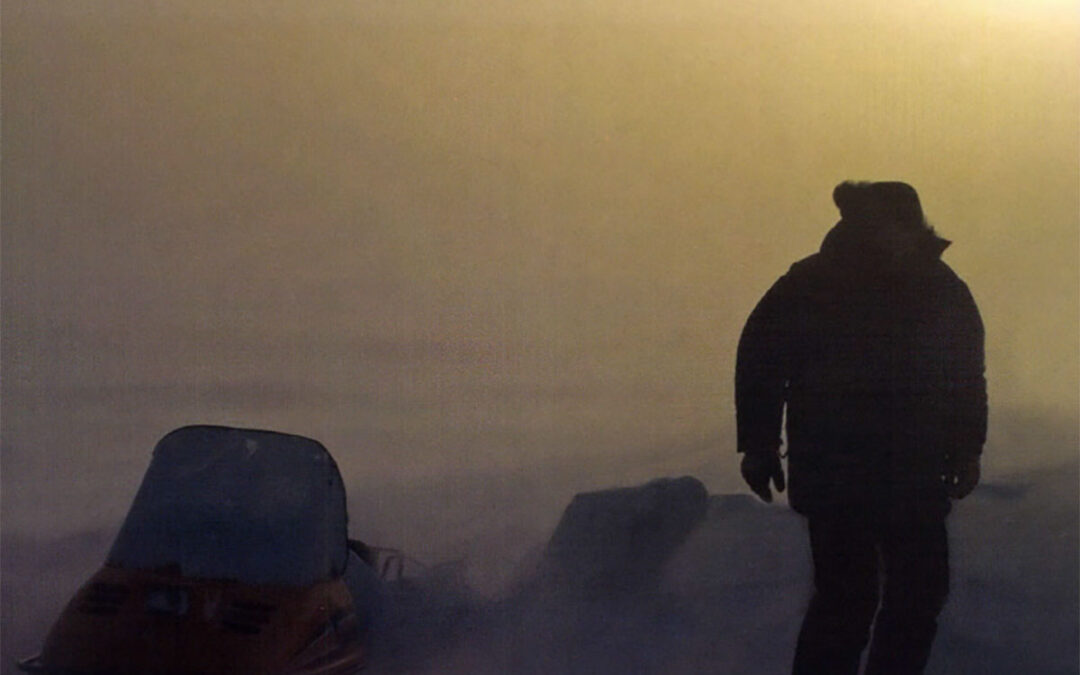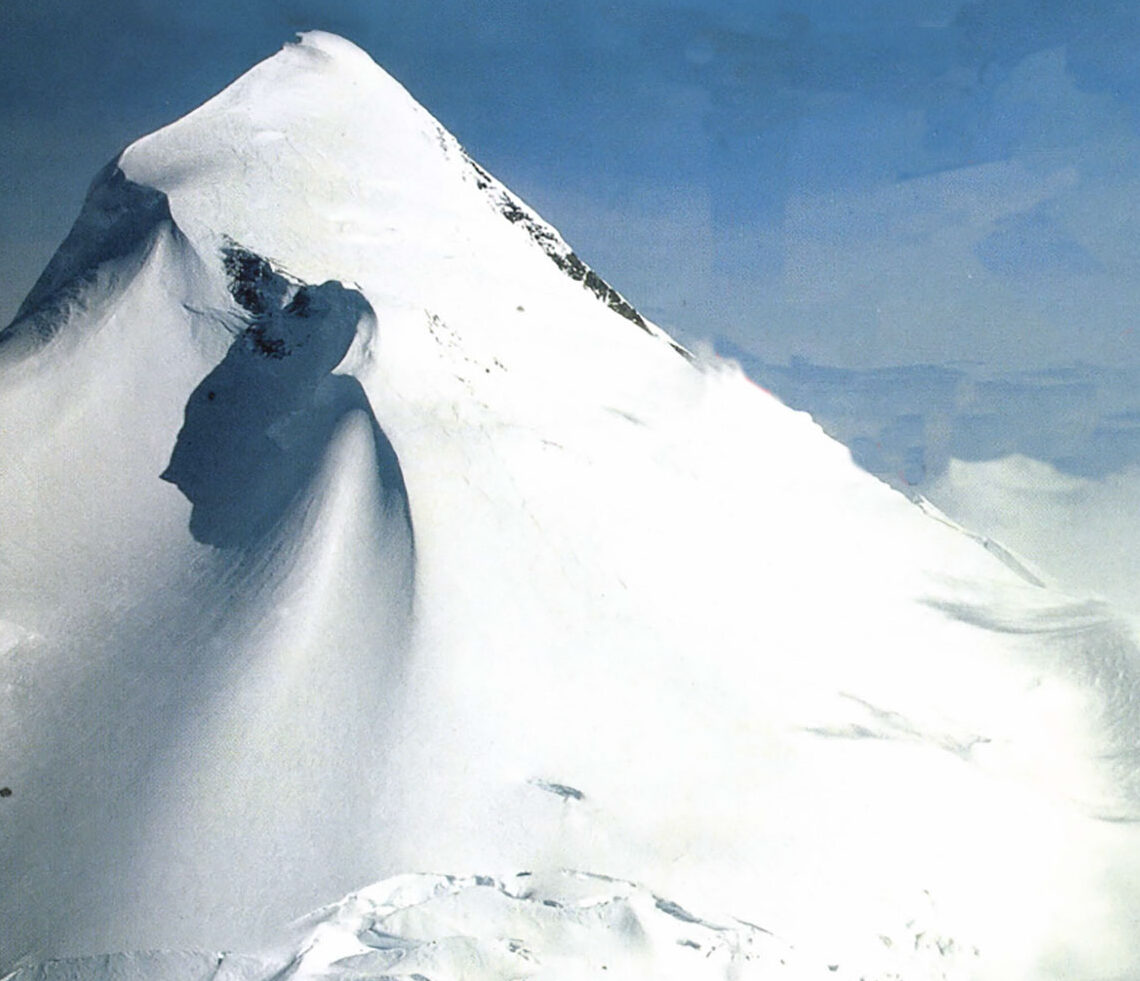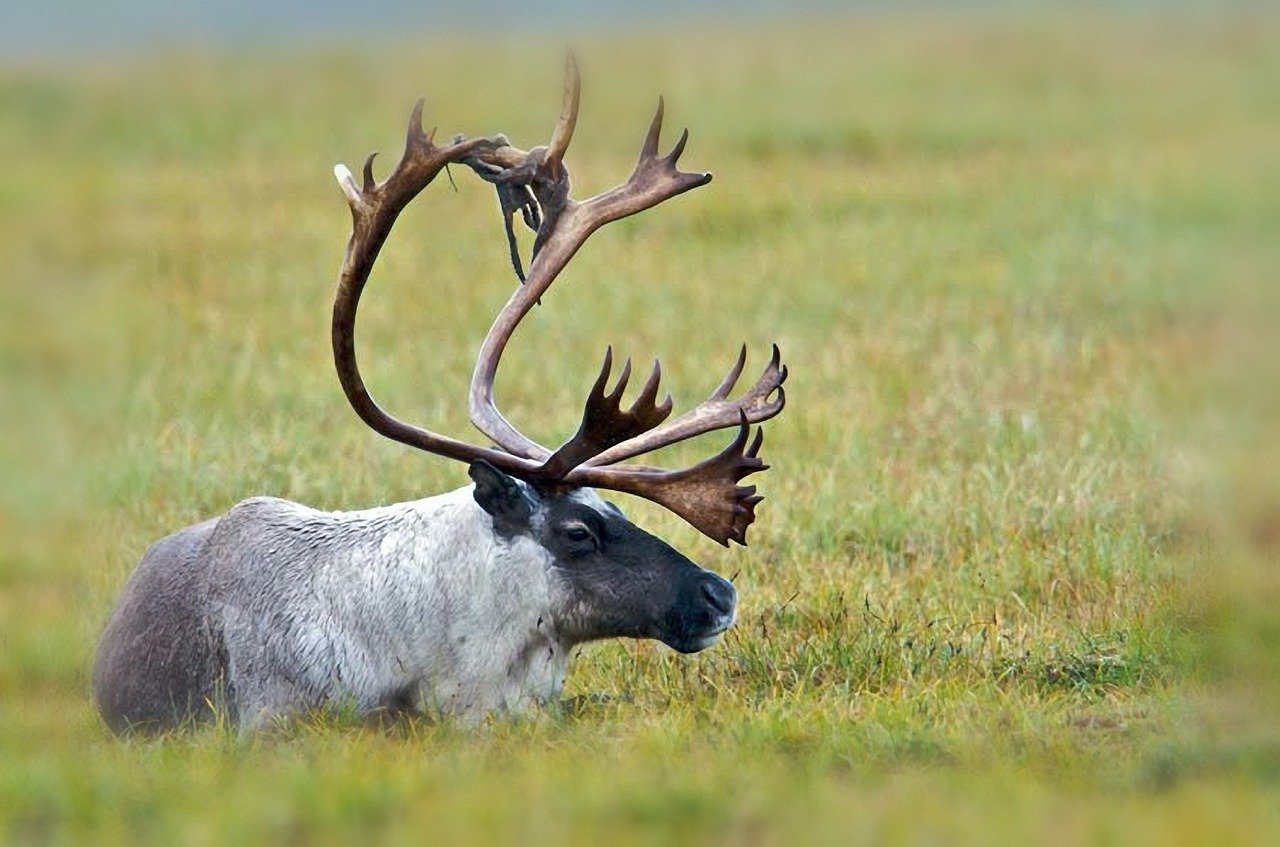I realized then I was on my own — alone in a vast wilderness of ice and snow.
Looking above camp toward where we’d be hunting brown bears, all we could see was snow and mountains, not a tree in sight. The only thing that wasn’t white was an occasional rock sticking out of the blanket of snow. It should be pretty easy to spot a bear in all that white, I thought.
Tyrell, my 30-year-old guide, and I had just settled into our base camp at the head of the Kipchuck river about 70 miles south of Aniak, Alaska. Little did we know that we’d be fighting for our lives the very next day.
About 8 a.m., Tyrell and I were loading our snowmobiles and getting ready to head into the high country. It was 20 degrees, overcast and breezy, but the forecast was for better weather.
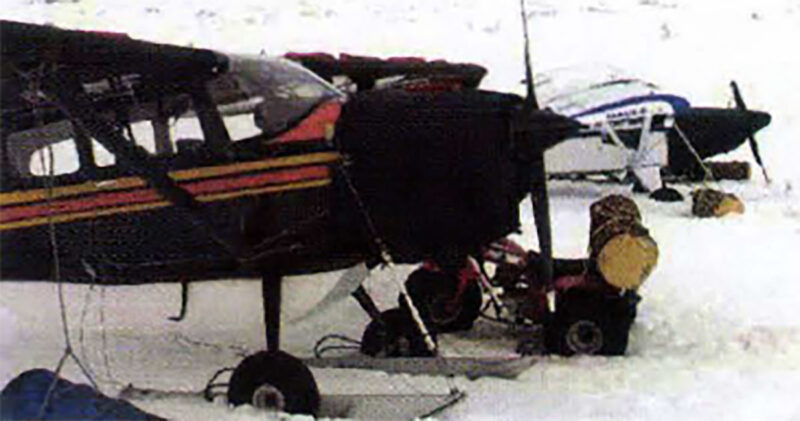
The bush planes had to be anchored down against the hurricane force winds.
The flat light made it hard to read the terrain, so we had to go slowly, which was OK with me because I was a novice on a snow machine. We glassed for a while from a ridge, then moved on. Since we would take the same route back at the end of the day, each of us put a waypoint into our GPS units.
Our pace slowed as the visibility worsened. I slowed down even more when Tyrell disappeared over a small incline ahead of me. When he didn’t reappear, I got worried and shut down my snowmobile. Suddenly, I heard what I thought was my name being yelled over the roar of the wind. I ran to where the sound was coming from and saw Tyrell at the bottom of a 20-foot-deep ravine with his snowmobile upside down and on top of him.
What I’d heard as “Scott” was actually “Stop!” He’d been screaming “Stop! Stop!” thinking I might plunge in right on top of him.
Tyrell was in a lot of pain, so I slid down the nearly vertical bank to check his injuries. The first thing I noticed was that his foot was pinned under the sled.
“I think my leg is broke,” Tyrell said. “Can you get this thing off of me?”
I tried but couldn’t budge the heavy sled. My best option was to dig under his leg to free it, but trying to do that without touching his injured leg was tough. The couple times I did bump it, Tyrell cried out in pain, but he never swore — not even once!
After digging out his foot, it was obvious something was broken since his toe was pointed one way and his knee another. As gently as possible, I moved his leg out from under the machine and did what I could do to make him comfortable.
Carrying him out on my machine didn’t seem like a very good idea for fear of doing more damage to his leg. We were only about 12 miles from camp, so we decided I would ride back and get help. Tyrell was worried that I would be unable to find my way back, but I assured him that with my GPS, it would be easy.
I got the water jug out of Tyrell’s pack and gave him two Snickers bars from my pocket. He kept saying, “I’m fine, just get going.” He was one tough cookie.
Deep in the ravine the snow had been falling straight down, belying the conditions at ground level where the wind was really blowing. I started my machine, then motored up the nearest hill, traveling the same way we came. When I got to the ridgetop, all I could see were the ski tracks of my snowmobile.
Moving at a snail’s pace, I headed toward the last waypoint a half-mile away. The only way to measure my speed was to put my foot on the snow every few minutes. Sometimes I was going too fast; other times I realized much to my surprise that I wasn’t moving at all! I soon found myself going downhill in the wrong direction and had to turn around, which really scared me. I was acutely aware that not only my life, but also Tyrell’s, depended on me getting back to camp for help.
Visibility improved as I drove farther down the ridge, so I was able to haul ass back to camp. A full hour had passed since I’d left Tyrell.
The poor guy has got to be scared to death, I remember thinking. We just met yesterday, so he has no idea if this dude from the Lower 48 can find his way back for help. For all he knows, I am hopelessly lost in the Alaskan wilderness.
I finally got back to camp and told our outfitter, Bob Adams, what happened. For the next hour, while Bob was busy tying down three airplanes before the wind blew them away, I rushed around with Bryan, an off-duty guide, to assemble a rescue toboggan.
It took about three hours for Bryan and me to reach Tyrell. Climbing down in the ravine with him, you would never know that a blizzard was raging just 20 feet above your head. It seemed 30 degrees warmer without the windchill.
Tyrell suggested we bust up his bipod to splint his leg, but my snowshoes made a much better splint than a broken-up bipod. Although I didn’t realize it at the time, giving up my snowshoes would almost cost me my life.
We finally got everything situated and started back. We were only two feet apart, but the wind was blowing so hard we had to yell to hear each other. I was in the lead breaking trail, since Bryan was on a heavier machine towing Tyrell. One of us would get stuck and the other would have to help. Then the other guy would bog down. It was really a chore getting the bigger sled unstuck with the toboggan behind it. A couple times we had to unhook before we could get going again. To make matters worse, my sled was starting to run poorly.
It took a long time, but we finally reached the ridgetop. The snow up there was packed by the wind, so we didn’t have a problem getting stuck anymore. Good thing, because I was exhausted from wrestling the heavy snowmobiles all day. Unfortunately, we were still plagued by zero visibility.
I put my GPS in the see-through map pocket of the saddlebag and just followed the needle, creeping along with Bryan right behind me. Every couple minutes I looked back to make sure everything was okay.
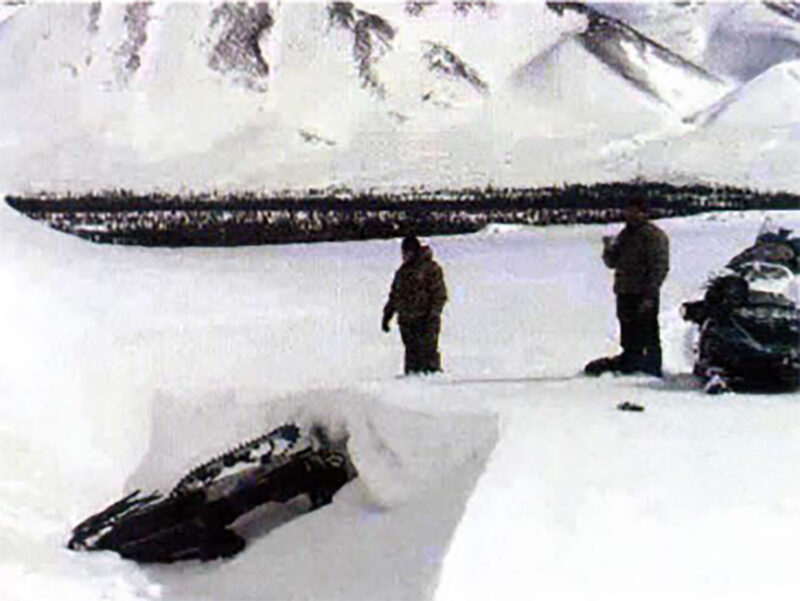
The guides snowmobile rests in a deep ravine, where the author’s life-and-death struggle began.
The next time I looked back to check on Bryan, however, all I could see was wall of white, so I stopped and shut off my machine for a minute so he could catch up. The wind was blowing directly at my back and several inches of snow had accumulated on my coveralls. I strained to hear his machine, but there was only the fierce howling of the wind.
It was difficult to stand up, but I leaned into the wind and walked back a little ways, hoping to find Bryan and Tyrell. After going about 50 feet, I was horrified to find that the snowmobile track I’d made five minutes ago was already obliterated by drifts. I could barely see my machine through the blizzard. No way in hell I am leaving my snowmobile, I thought.
Returning to my sled, I did what I hoped was a 180-degree turn and rode back for a couple hundred yards. With no track to follow and no sense of direction, I soon realized that was hopeless. The snow stung like needles on my cheeks, the only part of me that was exposed. Every few minutes, I had to use my finger like a windshield wiper to swipe the snow from my goggles. Praying for a miracle, I waited for the other guys to show up, my ears straining to hear their machine. No such luck.
I realized then I was on my own — alone in a vast wilderness of ice and snow.
Guilt weighed heavily on my mind as I swung in the direction my busted GPS told me to go. Leaving the others out in the blizzard nagged at me, but I had no idea how I might find them. Before continuing, I put a waypoint into the GPS so we could get a search party back there as soon as possible if the men didn’t show up at camp.
My sled continued to run rough because I could only inch along through the deep snow. Every hundred yards or so it would sputter and stop, and I would have to turn it on its side and rev up the engine to get it running again.
Next thing I knew I became stuck. The engine was running, but the track wasn’t turning; something had broken or frozen up. Dandy. I knew if I opened the hood, the wind would just rip it right off. Besides, I was not a snowmobile mechanic in the first place. I tried everything I could think of, which wasn’t much, before shutting it down.
I glanced at my GPS, which indicated that camp was 5.6 miles away.
It was 6 p.m. I had about 5 hours of light remaining.
Making what I’m sure was one of the most crucial decisions of my life, I grabbed my pack and GPS and headed out on foot. My Carharts, wool pants and socks were soaked from sweat and snow, but I was warm as long as I kept moving. I had a quart of water and three Snickers bars in my pack. Not much, considering I hadn’t eaten since breakfast.
The snow was mostly wind-packed, but I would hit a soft spot every few steps and plunge to my knees. My legs felt so heavy with fatigue I must have looked like an 80-year-old man trudging down the hall at the nursing home, or at least that’s how it felt. I lost my balance often, and each time I did, the wind would knock me down. Sometimes I would lie there and rest for a minute or two before getting up and moving again.
I came to a series of small hills blown bare by the wind, exposing the tundra and rocks in spots. The tundra was mushy and hard to walk on, but it beat breaking through the snow to my knees. The first tenth of a mile took forever. The next was even worse. I still had 5.4 miles to go, and at that point I was beginning to fear for my life. But the more I thought about it, the more I realized I could do nothing more than just keep walking.
The wind was gusting over my left shoulder pretty much the whole time, causing me to veer left and throwing me off course. After realizing this, I referred to my GPS the entire time.
Soon my GPS gave me a low battery warning. Good thing I didn’t take the extra batteries out to lighten my pack. There was a small pine tree maybe 75 yards ahead, which would be a good place to take a break and change the batteries. I should be there in a few minutes, I figured.
Twenty minutes later I reached the tree, which didn’t offer much in the way of protection. I didn’t want to get water inside the GPS, so I took off my soaking-wet gloves to change batteries. My fingers weren’t working very well, but I got the job done. It felt so good to sit there and relax. I laid back and closed my eyes just for a few seconds. Even though I was shivering, I could easily have fallen asleep.
Suddenly the realization hit like a hammer that if I fell asleep, I probably wouldn’t wake up. I thought about my wife, Jeannette, and the kids. That pushed me to get moving. Once I was up and walking again, the cold didn’t really bother me. The short rest had done some good, too.
After what seemed like forever, my GPS read 2.8 miles to camp — halfway home. I was really tired and sore, but not all that much worse than when I’d left the snowmobile. It was now 9 p.m. Three hours to get halfway; maybe I can make it after all.
Up ’til then I had been thinking my chances were 50/50, at best. I knew I could handle another three hours.
The wind had died way down and the snow was getting really wet. My coveralls must have weighed 20 pounds and I was soaked clear through. Without my snowshoes, I’d sink into the snow with every step, often to my knees. The next mile took almost two hours.
Resting for a couple minutes, I ate half of my last candy bar and drank a little water. The wet snow had turned to rain. Now I was sinking clear up to my crotch on every step. I also had to fight to untangle my boots from the brush buried by the snow. It took more than three hours before I could see the lights of the lodge a half-mile out. Man, what a sight!
The wind had died almost to nothing and I tried yelling for help, but no luck. I should be there in an hour.
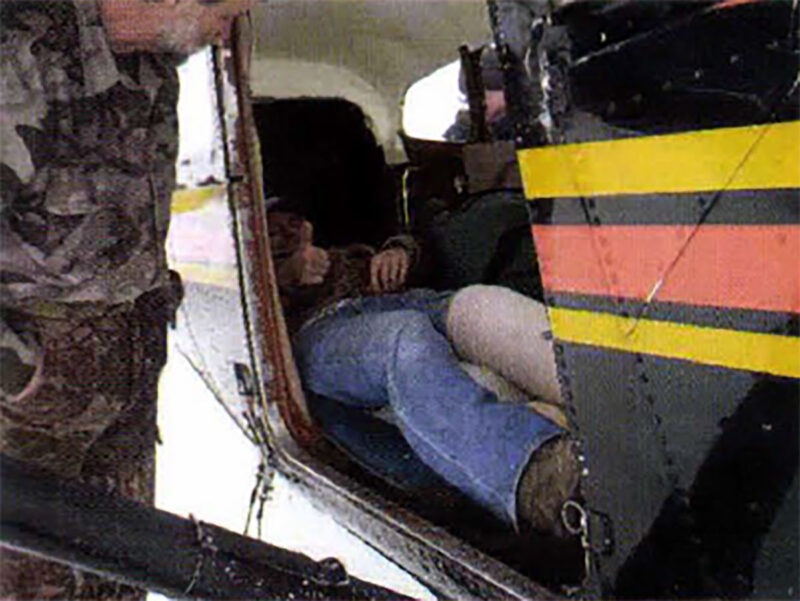
Tyrell, giving a thumbs up in the rescue plane as he awaits transport to the nearest hospital.
How was I going to face everybody after leaving Bryan and Tyrell out in that blizzard? God, I hope they got back okay. What a strange feeling to be so ecstatic about getting back alive, yet dreading to face the rest of the camp and telling them I left the other guys out there. Maybe they were already back. I sure hoped so. All I could do was keep moving.
What I thought would take an hour turned into more than three. It was close to daylight when I slogged my way to the cabin door. Inside, the cabin was dark and I nearly tripped over someone sleeping on the floor.
“Who’s there?” he asked.
“It’s me, Scott,” I answered weakly.
Bryan jumped up, gave me a big hug and said, “Man, am I glad to see you! We were afraid you were dead.”
The feeling was mutual to the tenth power.
”Where is Tyrell?” I asked.
“Over here, buddy,” came a voice by the stove.
Thank God, I thought.
I could barely feel it, but knew I was smiling.
Editor’s Note: After losing Scott in the storm, Tyrell and Bryan got stuck again. They tried to make a camp and remain where they were, but they were too cold and ended up riding back double on the snowmobile, despite Tyrell’s broken leg.
On April 21, 2005, Scott walked for 11 1/2 hours, overcoming sustained winds of 80 miles-per-hour and gusts up to 105. Five days after his near-death ordeal, Scott Brosvik killed a brown bear only a few miles from where he almost perished in the blizzard.
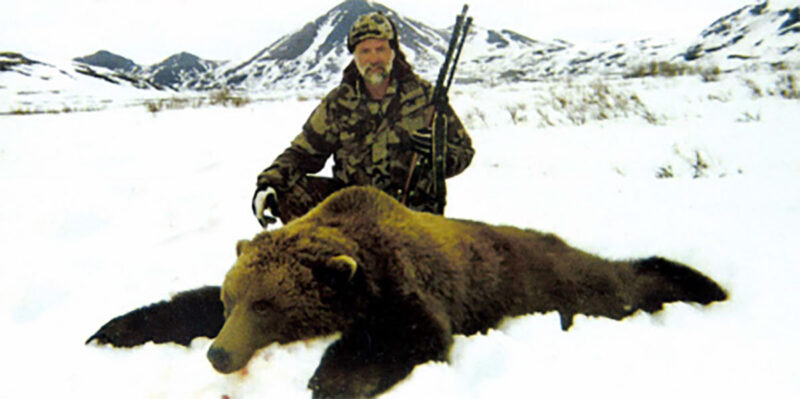
Scott Brosvik and his well-earned kill.
On November 11, 2006, Scott Brosvik died of arteriosclerosis. He left behind his wife of 30 years, and his four children. He was 52.
Our thanks to Matt Brosvik for sharing his father’s harrowing tale with our readers.
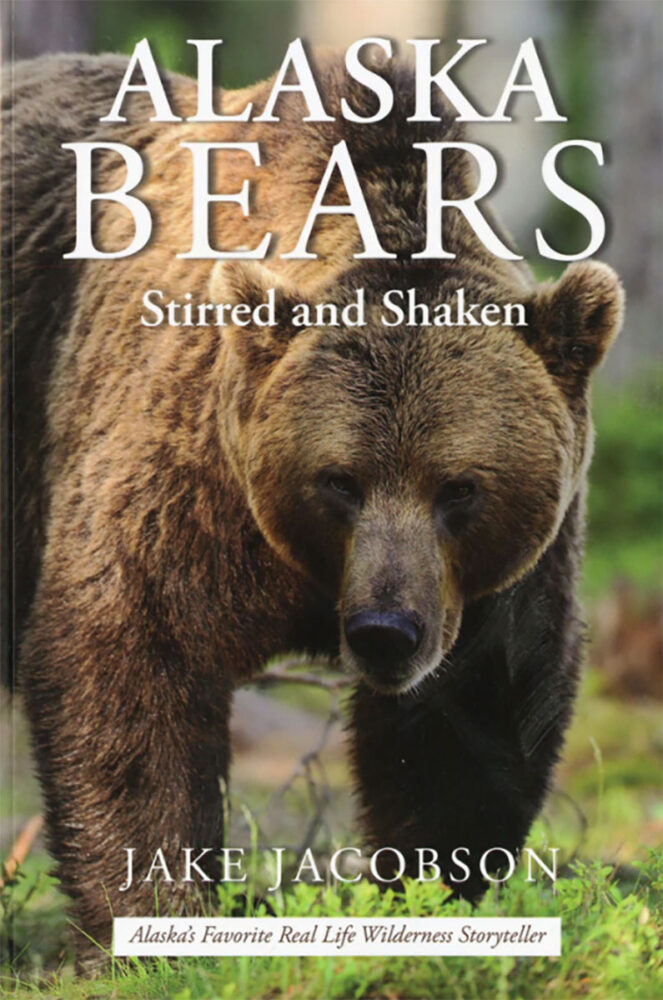 A collection of 24 stories describing Jake Jacobson’s personal experience hunting and guiding for all the species of bears in Alaska. Bear biology, hunting techniques, cabin depredations and avoidance thereof, and other aspects of bear pursuits are detailed. These are true stories except for the names of some of the hunting guests from Jake’s fifty years of living and hunting in Alaska.
A collection of 24 stories describing Jake Jacobson’s personal experience hunting and guiding for all the species of bears in Alaska. Bear biology, hunting techniques, cabin depredations and avoidance thereof, and other aspects of bear pursuits are detailed. These are true stories except for the names of some of the hunting guests from Jake’s fifty years of living and hunting in Alaska.
Jake came to Alaska in 1967 and among other things, he holds Alaska Master Guide license #54, a commercial Pilot license, a 100Ton Mariner’s license, is a Benefactor Life member of the NRA and has operated from his eighty acre private land located 155 miles north of the Arctic Circle since 1969. Buy Now

